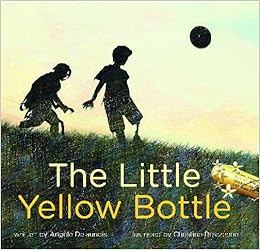
This is a
story about war and disability and how both affect innocent children. It is
also about resilience and optimism and children’s natural will to live and
play. This story could be used to help children recovering from any kind of war
situation, including terrorist attacks in the U.S. or anywhere in the world. It
might be especially relevant to children who lost limbs in the Boston Marathon
bombing last April. This story uses a role model—an adult who has been through
a similar attack—to inspire the child to keep living and realize his potential.
After the Boston Marathon attack, people who had lost limbs in the past came to
the hospitals in Boston to inspire those wounded in the attack. “People helping
people” is an important theme of this story.
Related Information
|
Comments
|
|
Title
|
The
Little Yellow Bottle
|
Translated from the
French: Petite bouteille jaune |
Author
|
Angele Delaunois
|
No specific web site
|
Illustrator
|
Christine Delezenne
|
|
Publisher
|
Second Story Press
|
|
Year
of Pub:
|
2011
|
|
ISBN:
|
978-1-926920-34-4
|
|
Age
range
|
6-12
|
Age range is my
opinion. This book could be read with younger children who have lost a limb
or whose siblings have lost a limb.
|
Type
of Disability
|
Physical
|
Loss of limbs
|
Fiction
or Nonfiction
|
Fiction
|
Theme of war; bombs
exploding where children are playing
|
Category: B
A) books that provide factual information about a disability
B) books that provide information about a disability in a story
format in which the character with a disability is integral to the plot
C) books that provide stories that have a character with a
disability who may or may not be integral to the story line and who has been
added to the story to achieve diversity and reflect reality
D) books that include a main character with a disability but
whose focus is not necessarily the disability
|
||
Annotation: Marwa and Ahmad are playing soccer in a shaded forest near their
village when Ahmad comes across a little yellow bottle. The children don’t
connect the bottle with the airplane that dropped bombs near the village a
few days before. Ahmad picks up the bottle, and it blows up, severely
injuring both children. Ahmed loses an arm and a leg, and Marwa, the narrator,
has cuts all over her body. The rest of the story is Marwa’s account of her
own recovery and how her friend Ahmed slowly returns to living and laughing,
learns to use crutches and then a prosthetic leg, and becomes the coach of the
soccer team. The illustrations are combinations of drawings, collage, and
photography. The dark colors and mixed media emphasize the characters’ physical
and emotional struggles as they heal.
|
||
Link
to publisher:
|
||
Links to professional reviews:
|
||
Awards:
|
If
you know of any rewards this book has received, please let me know.
|
|
Standards for Quality Portrayal
of Characters with a disability
|
Comments
|
|
1.
Promotes empathy not pity
|
Yes
|
|
2.
Promotes acceptance, not ridicule
|
Yes
|
|
3.
Emphasizes success rather than, or in addition to failure
|
Yes
|
Ahmed
learns to walk on his prosthetic leg and becomes a soccer coach.
|
4.
Promotes positive images of persons with disabilities or illness
|
Yes
|
|
5.
Assists children in gaining accurate understanding of the disability or
illness
|
Somewhat
|
|
6.
Demonstrates respect for persons with disabilities or illness
|
Yes
|
|
7.
Promotes attitude of “one of us” not “one of them.”
|
Yes
|
|
8.
Uses people-first language
|
Yes
|
|
9.
Describes the disability or person with disabilities or illness as realistic
(not subhuman or superhuman)
|
Yes
|
|
10.
Depicts people with disabilities as more similar to than different from other
people
|
Yes
|
|
11.
Shows peoples’ strengths and abilities along with their disabilities
|
Yes
|
|
12.
Represents characters as strong, independent people who others can admire or
learn from
|
Yes
|
Ahmed
is the best soccer coach the team has ever had.
|
13.
Represents people with disabilities from different racial and cultural
backgrounds, religions, age groups, and sexual orientations
|
Yes
|
Characters
have Arabic names (Marwa and Ahmed) and they are depicted as being from a
country in Africa or Asia.
|
14.
Shows people with disabilities in integrated settings and activities
|
Somewhat
|
|
15.
Shows people with disabilities in valued occupations and diverse roles.
|
Yes
|
Soccer
player, soccer coach, mentor
|
16.
Shows people with disabilities in reciprocal relationships
|
Yes
|
Marwa
and Ahmed remain good friends.
|
17.
Main character develops and grows emotionally as a result of what happens in
the story
|
Yes
|
Both
the narrator and her friend grow emotionally.
|
I love how you went into such detail with this!
ReplyDeleteThanks Christina. Interestingly, the Kirkus review was not very positive. I'd love it if you would become a follower of this blog.
DeleteWith the news from Syria, this book seems timely again. Or, even more saddening- when has it not been?
ReplyDelete